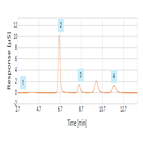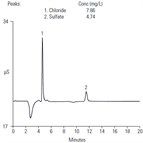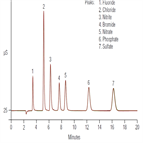Find methods for your needs
Refine by Feature
Displaying 1-4 of 4 results for Tag: Renewable Energy
Determination of Chloride in Algal Oil Using Combustion Ion Chromatography
Instrument Type: ICOil extracted from fish and algae is a renewable alternative to petroleum-based sources. If this oil is used as a lubricant, chloride needs to be monitored and its level minimized to reduce the likelihood that corrosive HCl will form. By using a combustion ion chromatography (CIC) system consisting of the automatic quick furnace AQF-2100H and an ICS-2100 ion chromatograph, the concentration of chloride can be determined accurately and quickly.
AN297: Determination of Total and Potential Sulfate and Total Chloride in Fuel-Grade Butanol Per ASTM D7319-09
Instrument Type: ICHere we present a direct injection IC approach to determine total and potential sulfate and total chloride in butanol intended as a gasoline additive. This IC method is consistent with the procedure described in ASTM D7319-09, a standard intended for the analysis of ethanol samples containing 1.0–20 mg/kg of total or potential inorganic sulfate and 1.0–50 mg/kg of inorganic chloride. This method also has the sensitivity to meet the specifications described in ASTM D4806-11A.
AN296: Assay of Fuel-Grade Butanol for Total and Potential Sulfate and Total Chloride Per ASTM D7328-07
Instrument Type: ICDescribed here is a simple ion chromatography (IC) method to determine total and potential sulfate and total chloride in butanol used as a gasoline additive. It is consistent with the procedure described in ASTM D7328-07, which is intended for the analysis of ethanol samples containing 0.55–20.0 mg/L total sulfate, 4.0–20 mg/L potential sulfate, and 0.75–50.0 mg/L chloride, but can also be applied to butanol samples.
AN1052: Determination of Chloride and Sulfate in Gasoline-Denatured Ethanol
Instrument Type: ICThis is a fast, simple, direct-injection IC method with eluent generation to determine total and potential sulfate and chloride in gasoline-denatured ethanol samples. This approach is consistent with ASTM D7319-12. The study shows good column ruggedness with no column deterioration over more than 400 sample injections. The method described can reliably quantify sulfate and chloride at 65 μg/L and 18 μg/L, respectively-concentrations that are well below the ASTM D4806 specifications of 4 mg/L for sulfate and 40 mg/L for chloride.




